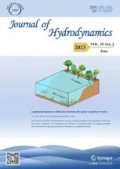Abstract
In this study, an efficient numerical method for predicting the wake interference of multiple turbines is presented. The actuator line (AL) model instead of the geometry-resolved method is adopted to represent the rotor. The Large-eddy simulation (LES) is performed to predict wakes of multiple turbines operated in turbulent flows. An efficient immersed boundary (IB) method with moving least square reconstruction (MLS) is developed to model the nacelle and support structure of the tidal turbine. A simple wall function based on the MLS-IB method and boundary-layer equations is employed to compute the instantaneous wall shear stress. Laminar flow simulations of unsteady flows past a cylinder illustrate the accuracy of the wall function IB method. Finally, the proposed method is extended to study turbulent flow past tandem tidal rotors, in which the wake profile behind rotors is analyzed. The results are found to be in reasonable agreement with published data.
Similar content being viewed by others
References
Mycek P., Gaurier B., Germain G. et al. Experimental study of the turbulence intensity effects on marine current turbines behaviour. Part II: Two interacting turbines [J]. Renewable Energy, 2014, 68: 876–892.
Stallard T., Collings R., Feng T. et al. Interactions between tidal turbine wakes: Experimental study of a group of three-bladed rotors [J]. Philosophical Transactions of the Royal Society of London A: Mathematical, Physical and Engineering Sciences, 2013, 371(1985): 20120159.
Krogstad P. Å., Eriksen P. E. “Blind test” calculations of the performance and wake development for a model wind turbine [J]. Renewable Energy, 2013, 50: 325–333.
Peskin C. S. Flow patterns around heart valves: A numerical method [J]. Journal of Computational Physics, 1972, 10(2): 252–271.
Liu C., Hu C. An efficient immersed boundary treatment for complex moving object [J]. Journal of Computational Physics, 2014, 274: 654–680.
Liu C., Hu C. An adaptive multi-moment FVM approach for incompressible flows [J]. Journal of Computational Physics, 2018, 359: 239–262.
Balaras E., Benocci C., Piomelli U. Two-layer approximate boundary conditions for large-eddy simulations [J]. AIAA Journal, 1996, 34(6): 1111–1119.
Cabot W., Moin P. Approximate wall boundary conditions in the large-eddy simulation of high Reynolds number flow [J]. Flow, Turbulence and Combustion, 2000, 63(1-4): 269–291.
Tessicini F., Iaccarino G., Fatica M. et al. Wall modeling for large-eddy simulation using an immersed boundary method [R]. Annual Research Briefs, Stanford, CA: Stanford University Center for Turbulence Research, 2002, 181–187.
Vanella M., Balaras E. A moving-least-squares reconstruction for embedded-boundary formulations [J]. Journal of Computational Physics, 2009, 228(18): 6617–6628.
Liu C., Hu C. Block-based adaptive mesh refinement for fluid structure interactions in incompressible flows [J]. Computer Physics Communications, 2018, 232: 104–123.
Cristallo A., Verzicco R. Combined immersed boundary/ large-eddy-simulations of incompressible three dimensional complex flows [J]. Flow, turbulence and combustion, 2006, 77(1-4): 3–26.
Sørensen J. N., Shen W. Z. Numerical modeling of wind turbine wakes [J]. Journal of Fluids Engineering, 2002, 124(2): 393–399.
Ong L., Wallace J. The velocity field of the turbulent very near wake of a circular cylinder [J]. Experiments in Fluids, 1996, 20(6): 441–453.
Kravchenko A. G., Moin P. Numerical studies of flow over a circular cylinder at Re = 3 900 [J]. Physics of Fluids, 2000, 12(2): 403–417.
Cardell G. S. Flow past a circular cylinder with a permeable wake splitter plate [D]. Doctoral Thesis, Pasadena, USA: California Institute of Technology, 1993.
Beaudan P., Moin P. Numerical experiments on the flow past a circular cylinder at sub-critical Reynolds number [D]. Doctoral Thesis, Palo Alto, USA: Stanford University, 1994.
Zhou Y., Antonia R. A. A study of turbulent vortices in the near wake of a cylinder [J]. Journal of Fluid Mechanics, 1993, 253: 643–661.
Ahmadi M. H. Influence of upstream turbulence on the wake characteristics of a tidal stream turbine [J]. Renewable Energy, 2019, 132: 989–997.
Li X., Li M., Mclelland S. J. et al. Modelling tidal stream turbines in a three-dimensional wave-current fully coupled oceanographic model [J]. Renewable Energy, 2017, 114: 297–307.
Author information
Authors and Affiliations
Corresponding author
Additional information
Biography: Cheng Liu (1987-), Male, Ph. D., Assistant Professor
Rights and permissions
About this article
Cite this article
Liu, C., Hu, C. CFD simulation of tidal current farm by using AL model. J Hydrodyn 31, 34–40 (2019). https://doi.org/10.1007/s42241-019-0010-8
Received:
Revised:
Accepted:
Published:
Issue Date:
DOI: https://doi.org/10.1007/s42241-019-0010-8




